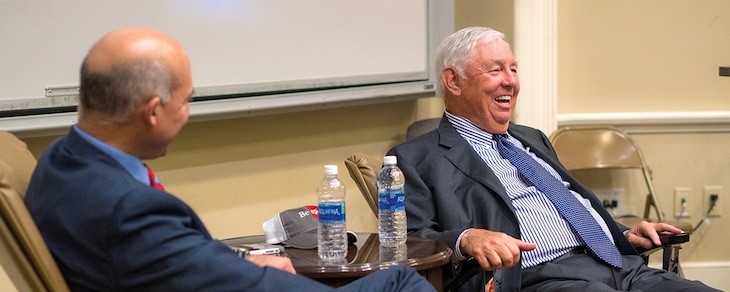Dillard’s CEO says family’s retail chain is a survivor
by December 17, 2017 5:57 pm 18,480 views

(right) Bill Dillard II, CEO and chairman of Little Rock-based Dillard’s
Department store retail is a business in transition and barely a month goes by without news of store closures leaving shopping malls with empty space. This year through Nov. 17, there were 6,700 store closure announcements, surpassing the 2008 record of 6,163, according to Deborah Weinswig of Fung Global Retail & Technology.
The major reasons cited for the closures include declining mall traffic, reconfiguration of store networks as more sales move online and trying to cut losses from unprofitable stores.
Little Rock-based Dillard’s is not among the chains announcing numerous store closures. Dillard’s operates 268 stores and 25 clearance centers in 29 states and an internet store. As of Jan. 31, Dillard’s owned 245 of its stores. Last year the company’s total sales revenue was $6.256 billion, down 5% from the previous year. Through nine months of 2017 sales revenue was $4.2 billion, down from $4.321 billion in the year-ago period.
Bill Dillard II, CEO and chairman of Dillard’s, said it’s more important today to run a few profitable stores than to have stores everywhere. He recently told students at the University of Arkansas his family’s retail chain would be a survivor in the transitional time for the industry. He said it’s not the first time he’s seen retail shift during his 50 years in the business.
He said Sears is closing so many stores it is disrupting mall operations.
“When the anchor pulls out, other tenants sharing that wing will also be lost and then investors are left scrambling with empty space,” he said. “I am having those conversations with mall operators all the time.”
Today’s model for shopping centers should not devote more than 30% of the square footage for apparel retailers, he said. It’s important to have entertainment venues or restaurants that can make the stores destinations like Bass Pro Shops or Dave & Buster’s.
GROWING DILLARD’S
Dillard, 72, grew up in Texarkana and his father, Bill Dillard Sr., began running a five-and-dime store in his hometown of Nashville, Ark., in the late 1930s before opening his first department store in Texarkana in 1948.
Dillard told the UA students the family grew the department store chain by acquisition, starting in the 1950s with the purchase of Mayer & Schmidt in Tyler, Texas, and a store in Tulsa. He said the family moved to Oklahoma and his dad had a knack for turning around underperforming stores, which at that time were mostly located in downtown areas.
In the late 1960s, Dillard said his father acquired two stores in Little Rock and in 1968 moved the headquarters to Little Rock before taking the company public in 1969. He said as the first shopping malls were popping up in the south, Dillard’s connected with mall developers and began opening new stores as well as acquiring others.
“It was a different world back then. Mall developers sought us out to put in new stores. Us, JC Penney and Sears would typically anchor various ends of large shopping malls like the one in Fayetteville,” Dillard said.
He said throughout the 1980s and 1990s, Dillard’s business began to change as the company worked with consolidators to buy up independent retail chains across the country, adding more than 130 stores and substantial real estate holdings to the company’s assets.
ONLINE EXPANSION, SURVIVING
Dillard said like most department store chains, the growth of online sales reduces foot-traffic in malls. He said stores can’t compete with the inventory assortment online which is why his company has been proactive about expanding its online presence over the past few years. He said 40% of Dillard’s capital spending is earmarked for technology investment, and that’s been the case for the past several years.
“Our internet sales have been growing by 15 to 17% for years,” Dillard said.
He told the students Dillard’s online sales are roughly 10 times that of its second-highest performing store. When asked if retailers or investors planned to build more stores in urban areas, Dillard said he doesn’t foresee it. He said mall construction has halted, and there’s just one new mall being built in the entire U.S. And that location is in the Northeast.
When asked about the biggest change Dillard’s faces, he said, “So much energy goes into being a survivor.” He said Dillard’s internet business is not like Amazon’s because there is still a motive to be profitable.
“Amazon has had three years in the black, and that’s because it’s making money on its web services. But its retail model is not. Zappos, owned by Amazon, has never made any money. That said, Amazon is an incredible disruptor,” Dillard added.
He said retailers who survive have to be flexible and as nimble as possible.
“Used to we looked for huge growth prospects in this business. Today we’re just hopeful for growth of any kind,” he said. “Dillard’s has very little debt, and the best prospects for our abundant free cash is to buy back our own stock, which we know is a conservative play.”
In 10 years, Dillard said there will be far fewer retail stores in the U.S., and he foresees more retailers moving to showroom-type stores which is a throwback to the old catalog stores that once existed.
Lastly, he said getting the assortment right is another big challenge. Inventory can no longer be “just good enough” to please the consumer. With a plethora of online competition, assortment has to be spot on for the retailer to get the sale, and much of the time it’s also got to be discounted.
“I think there will always be a need for some brick and mortar. Not everyone is going to buy everything they need online,” Dillard said.
